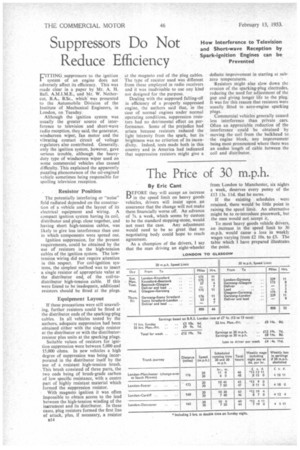Suppressors Do Not Reduce Efficiency
Page 48

If you've noticed an error in this article please click here to report it so we can fix it.
How Interference to Television and Short-wave Reception by Spark-ignition Engines can be Prevented
FITT1NG suppressors to the ignition system of an engine does not adversely affect its efficiency, This was made clear in a paper by Mr. A. H. Ball. A.M.I.M.E., and Mr. W. Nethercot. B.A., B.Sc., which' was presented to the Automobile Division of the Institute of Mechanical Engineers, in London, on Tuesday.
Although the ignition system was usually the greater source of interference to television and short-wave radio reception, they said, the generator, windscreen wiper, fan motor and the vibrating contact circuit of voltage regulators also contributed. Generally, only the ignition system, however, gave serious trouble, although the heavyduty type of windscreen wiper used on some commercial vehicles also caused difficulty. This explained the apparently puzzling phenomenon of the oil-engined vehicle sometimes being responsible for spoiling television reception.
Resistor Position
The potentially interfering or "noise" field radiated depended on the construction of a vehicle and the layout of its electrical equipment and wiring. A compact ignition system having its coil, distributor and plug:, close together, and having short high-tension cables, was likely to give less interference than one in which components were spread out.
Ignition suppression, for the present requirements, could be obtained by the use of resistors in the high-tension cables of the ignition system. The lowtension wiring did not require attention in this respect. For coil-ignition systems, the simplest method was to insert a single resistor of appropriate value at the distributor end of the coil-todistributor high-tension cable. If this were found to be inadequate, additional resistors should be fitted at the plugs.
Equipment Layout
If these precautions were still unavailing, further resistors could be fitted at the distributor ends of the sparking-plug cables. In all vehicles tested by the authors, adequate suppression had been obtained either with the single resistor at the distributor or with the distributorresistor plus units at the sparking plugs.
Suitable values of resistors for ignition suppression were between 5,000 and 15,000 ohms. In new vehicles a high degree of suppression was being incorporated in the distributor itself by the use of a resistant high-tension brush. This brush consisted of three parts, the two ends being of brush-grade carbon of low specific resistance, with a centre part of highly resistant material which formed the suppression resistor.
With magneto ignition it was often impossible to obtain access to the lead between the high-tension winding of the instrument and its distributor. In these cases, plug resistors formed the first line of attack, plus, if necessary, a resistor
at the magneto end of the plug cables. The type of resistor used was different from those employed in radio receivers and it was inadvisable to use any kind not designed for the purpose.
Dealing with the supposed falling-off in efficiency of a properly suppressed engine, the authors said that, in the case of normal engines under normal operating conditions, suppression resistors had no detrimental effect on performance, Some of the prejudice had arisen because resistors reduced the light intensity from the spark, but its brightness was no criterion of its incendivity. Indeed, tests made both in this country and in America had indicated that suppression resistors might give a definite improvement in starting at subzero temperatures.
Resistors might also slow down the erosion of the sparking-plug electrodes. reducing the need for adjustment of the gap and giving longer life to the plug. It was for this reason that resistors were usually fitted to aero-engine sparking plugs.
Commercial vehicles generally caused less interference than private cars. Often an appreciable reduction of the interference could be obtained by moving the coil from the bulkhead to the engine block, any improvement being most pronounced where there was an undue length of cable between the coil and distributor.




















































































